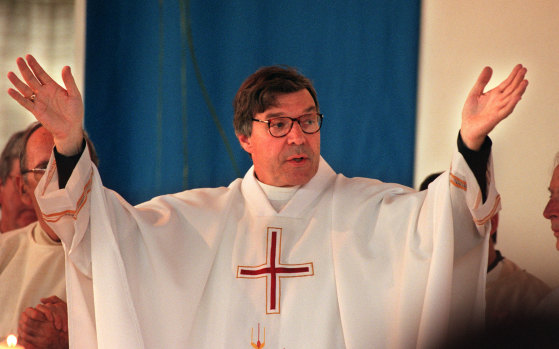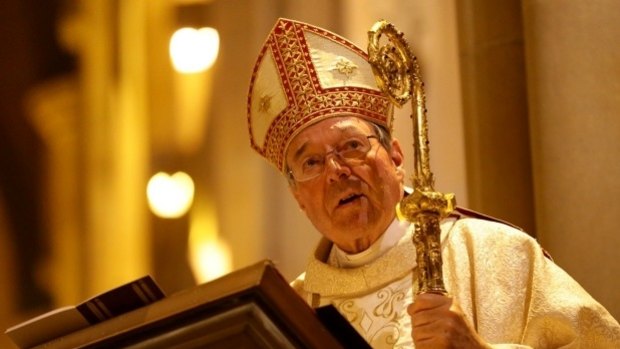This was published 6 years ago
Pell was always crucial to the church's war on its own victims
EDITOR'S NOTE: The High Court overturned Cardinal George Pell's conviction for historic child sex offences in a judgment handed down April 7, 2020. In a unanimous decision all seven High Court judges found Victoria's Court of Appeal should not have upheld Pell's conviction. It found the evidence could not support a guilty verdict.
Cardinal George Pell’s fall is remarkable not just because he is the most senior of the many thousands of Catholic priests accused of sexual abuse around the world to be convicted, but because he has done more than any other to defend the church against its victims.
By some estimates, Pell's legal aggression and organisational brilliance has saved the church hundreds of millions of dollars.
Pell was the key architect of two bulwarks the church used in Australia to reduce compensation payouts.

George Pell in 1996 after he was installed as Melbourne archbishop.Credit: John Lamb
Upon being named as Archbishop of Melbourne in 1996, Pell established what became known as the "Melbourne Response" to deal with complaints of sexual abuse.
Pell's protocol was quickly adopted in Victoria, in no small part due to his nimble and effective political work.
Critics of the Melbourne Response - including victims of sexual abuse by priests - say that it is far more legalistic than the Church's national approach, known as Towards Healing. It also capped payouts to victims at $50,000, a figure that was later increased to $75,000.
"I have tried to be prudent with money, but my record shows that I have acted compatible with the general standards of the community and I have tried to be generous," Pell testified before a Victorian state inquiry in 2013. "In any position in which I have had the lead, we have fully respected the obligations to compensation."
It was later estimated the Melbourne Response saved the Catholic Church from paying up to $62 million compensation to victims of sexual abuse.
In 2001, Pell was appointed Archbishop of Sydney where under his leadership the archdiocese adopted an aggressive legal stance against its victims.
Central to it was the "Ellis defence", named after John Ellis, a former altar boy who had tried to sue the church for abuse he had suffered at the hands of a priest. As his abuser had died and as the church had been structured as an unincorporated association - a body that barely exists in legal terms - Ellis was left with no one to sue.

Cardinal George Pell speaks at a mass at St Mary's Cathedral in Sydney in 2014. Credit: Wolter Peeters
Under the Ellis Defence, the church's vast wealth in Australia - estimated in 2017 to extend to $76.5 billion worth of properties and other assets, and an annual income of $11.5 billion a year from businesses in the areas of education, health and welfare services - was out of reach to victims in pursuit of compensation.
This was in contrast to the situation in America, where billions were awarded against the church for similar crimes. The largest single settlement in the US was against the archdiocese of Los Angeles, which in 2007 paid out $660 million to 508 victims of clerical abuse.
According to Peter Gogarty, a survivor of abuse by priests and advocate for survivors, Pell’s strategies were designed not only to spare the church its staggering fortune, but in the service of omerta (a code of honour and code of silence that places importance on silence in the face of questioning by authorities or outsiders). Those victims who managed to secure a small payout would only receive it if they surrendered any future claims against the church and kept silent.
Further, those whose legal bids against the church failed could expect to be attacked. Though the church’s own investigation found it likely that Ellis had been abused, rather than offering him an apology or compensation, Pell spent $1.5 million in a legal assault, subpoenaing Ellis' former employer and approaching his former colleagues and ex-wife for statements. When Ellis lost his case on appeal, the church pursued him for costs at Pell's direction.
"The hypocrisy is staggering," says Mr Gogarty now, speculating on how much Pell's own defence must have cost so far.
Pell would fight bitterly against plans to hold a royal commission into institutional abuse of children, a battle he finally lost.
By the time he was called to give evidence to the commission, Pell had again been promoted and was serving in Rome as the church's treasurer, the third most powerful man in the Holy See. He had become famous for discovering billions of dollars illicitly stashed away in the Vatican's coffers.
When he finally came to give evidence to the commission via video link, he was asked how he could not have known of notorious paedophile Gerald Ridsdale's relentless abuse of the boys in his care - considering they lived and worked in the same parish and even shared a house at one point.
"It's a sad story and it wasn’t of much interest to me," he replied.